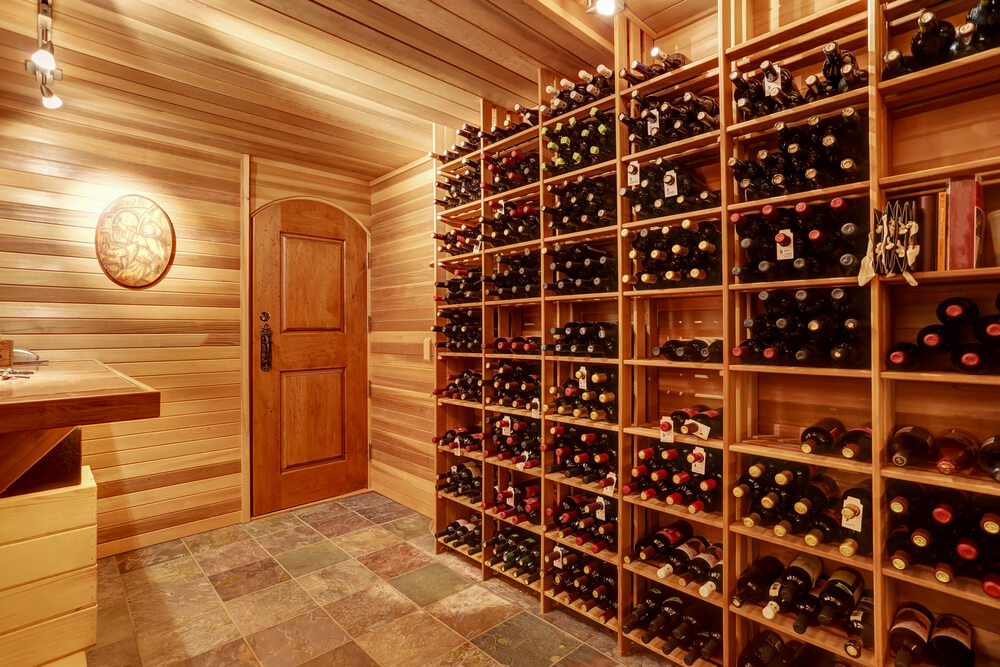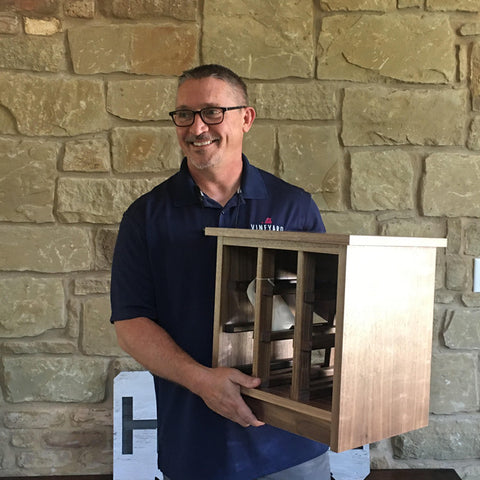Dreaming of that perfect space to showcase your growing wine collection? A custom wine cellar increases your home's value and protects wine investments. The challenge? Making common storage mistakes that can compromise your bottles and the cellar itself.
Let's walk through the common mistakes to avoid as homeowners when designing wine cellars.
Wine Cellar Mistakes to Avoid and Quick Fixes
Don’t Choose the Wrong Location for Your Wine Cellar
Do Consider Your Location Options
While basements offer ideal conditions for wine cellars, you have several options for creating proper storage space in your home:
-
Below ground is best – Basements naturally keep a consistent environment ideal for wine
-
Interior rooms work well – Spaces without exterior walls protect from seasonal temperature swings
-
Avoid heat sources – Keep your collection away from kitchen equipment, vents, and sunny areas
-
Consider closet conversion – Interior closets can be transformed into mini cellars with proper insulation
-
Avoid exterior walls – These transmit outdoor climate fluctuations that can damage your wine
-
Skip the garage – Most garages lack the climate control needed for liquid gold that you plan to drink later
-
Upgrade from a refrigerator – Standard kitchen fridges are too cold and dry for proper wine storage. Choose from our quality wine fridges.
-
Install dedicated racks – In whatever space you choose, adequate wine shelves provide stable bottle positioning
Don’t Expose Your Wine Bottles to Excess Sunlight
Do Store Your Wine in Complete Darkness for Best Results
Like vampires, fine wine bottles need protection, especially from direct sunlight. This is why many wines are stored in darker bottles. Remember:
-
Avoid windows altogether – Both exterior and interior windows can compromise your collection
-
Go windowless – Skip those stylish inset windows that let light into your cellar
-
Never use your garage for long-term storage – These places typically have poor light control and climate fluctuations
-
Consider proper lighting – Install LED lights with timers (they produce no heat or UV radiation)

Don't Create an Improperly Sealed Space
Do Ensure Your Wine Cellar is Completely Airtight
An improperly sealed wine cellar is one of the most overlooked yet critical mistakes to avoid. Here’s how to create an airtight, properly sealed wine storage:
-
Choose an exterior-grade door designed for insulation and temperature stability
-
Ensure the door is fully sealed with proper weather stripping around all edges
-
Add a bottom sweep or threshold barrier to prevent airflow under the door
Don’t Let Your Wine Cellar Get Too Hot
Do Keep Your Cellar Comfortably Cool
Temperature control is crucial for preserving your selection's quality and tasting profile, so a cooler is essential for your cellar.
Guidelines for storing wines:
-
50°F-60°F is ideal for most wines (not your home's comfortable 70°F)
-
White wine and sparkling wines prefer the cooler end (around 50°F)
-
Red wines do better at the warmer end (around 60°F)
-
Avoid standard refrigerator temperatures (typically 38°F), which are too frigid for proper aging
Choose premium wine cooling units and wine coolers for appropriate storage.
Don't Allow Your Cellar to Get Too Cold
Do Mimic the Environmental Conditions of a Below-Ground Cellar
When storing wine for future enjoyment, temperature balance is critical.
-
Never let wine freeze – A frozen bottle of wine expands, potentially breaking or pushing out the cork
-
Avoid standard fridge temperatures – Your kitchen refrigerator (typically 38°F) is too cold for wines
-
Consider separate zones if you drink different wine varieties that benefit from varied temperatures
Don’t Let Your Wine Cellar Dry Out
Do Maintain the Proper Humidity Level in Your Cellar
To properly support your wine collection, your cellar needs to maintain the right amount of humidity. If it’s too dry, the corks will likewise dry out and expose the wine to air. If the cellar is too humid, mold can grow and the wine labels may start to peel off.
This is why we recommend keeping your humidity between 50% to 70%. You can purchase a cooling unit with an optional integrated humidifier, such as the CellarPro Air Handler 8500 Vertical #7109.
Don't Let Your Wine Cellar Dry Out
Do Maintain the Proper Humidity Level in Your Cellar
Essential guide for preserving your fine collection:
-
Keep humidity between 50%-70% – This sweet spot preserves corks without damaging labels
-
Too dry (below 50%) – Corks shrink and allow air to oxidize your bottle of wine
-
Too humid (above 70%) – Mold develops, reducing both drinkability and value
-
Consider integrated solutions – Units like the CellarPro Air include climate control
Don't Let the Humidity Destroy Your Cellar Walls
Do Protect Your Walls From Excess Humidity
Creating the ideal environment for storing wine requires protecting the structure itself:
-
Install a proper vapor barrier – High-density closed-cell foam prevents moisture migration
-
Safeguard your wine labels – Proper vapor barriers help keep optimal humidity that won't damage labels
-
Prevent mold growth – Proper barriers and a quality cooler can prevent mold from developing on walls and affecting your wine.
Don't Allow Vibrations to Destroy Your Wine
Do Eliminate Every Source of Vibration When Storing Wine in Your Cellar
Vibration is an often-overlooked enemy of proper wine storage:
-
Keep wine away from appliances – Washing machines, dryers, and HVAC equipment produce harmful vibrations
-
Avoid high-traffic areas – Even footsteps above your cellar can disturb resting wine
-
Choose solid wine racks – Quality products minimize unnecessary movement when retrieving your collection
-
Use wine fridges with anti-vibration features if a completely vibration-free space isn't possible
Don't Store Your Bottles Upright
Do Store Your Bottles Sideways to Prevent Accidental Spoilage

Storing vino upright might look tidy, but it’s not long-term ideal. Here’s why storing sideways is the way to go:
-
Keeps the cork moist, preventing it from drying out and letting air seep in
-
Preserves the integrity of your wine and prevents early oxidation
-
Maximizes rack space while creating an attractive and modern display. Check out our wine rack inspiration gallery.
-
Reduces vibration and movement, which can disturb the wine
Note: If you're storing bottles with screw tops, this rule doesn't apply.
Don’t Store the Wrong Type of Wine in Your Cellar
Do Discover Which Wine to Store and Which to Enjoy Immediately
Not every wine gets better with age. Here’s what to keep in mind:
-
Most wines (especially whites, rosés, and sparkling wines) are best consumed within 2–3 years
-
Bold reds like Cabernet Sauvignon or Syrah may benefit from maturing for the perfect tasting
-
Track expiration dates and drink accordingly to avoid waste
Don't Add New Wines Yet
Do Build Your Cellar Before Your Collection
Storing wine without the proper environment is one of the more common wine storage mistakes that can spoil your investment before it even begins. Instead:
-
Hold off on purchases until your cellar is climate-controlled
-
Avoid temporary storage in places like the kitchen, where the climate fluctuates
-
Plan your layout first, then build your vino library to fit the space and organization system
Get expert wine cellar consultation for FREE. Contact us today.
Don't Store Your Wines Haphazardly in Your Cellar
Do Organize Your Wine Collection
A well-organized cellar makes storing wine easier and protects bottles from unnecessary handling or disruption.
To stay organized:
-
Group bottles by type, varietal, or region for quick access
-
Place everyday wines in front or at arm’s reach, so you don’t disturb aging bottles and affect flavors
-
Use a digital inventory system to track age and rotation
-
Limit access or door openings to maintain a consistent climate
Key Takeaway
A well-designed wine cellar is your best defense against storage mistakes that can ruin your investment. From sealing the room properly to storing bottles correctly, keeping your cellar cool, dark, and organized will preserve the quality of your wine collection for years to come.


